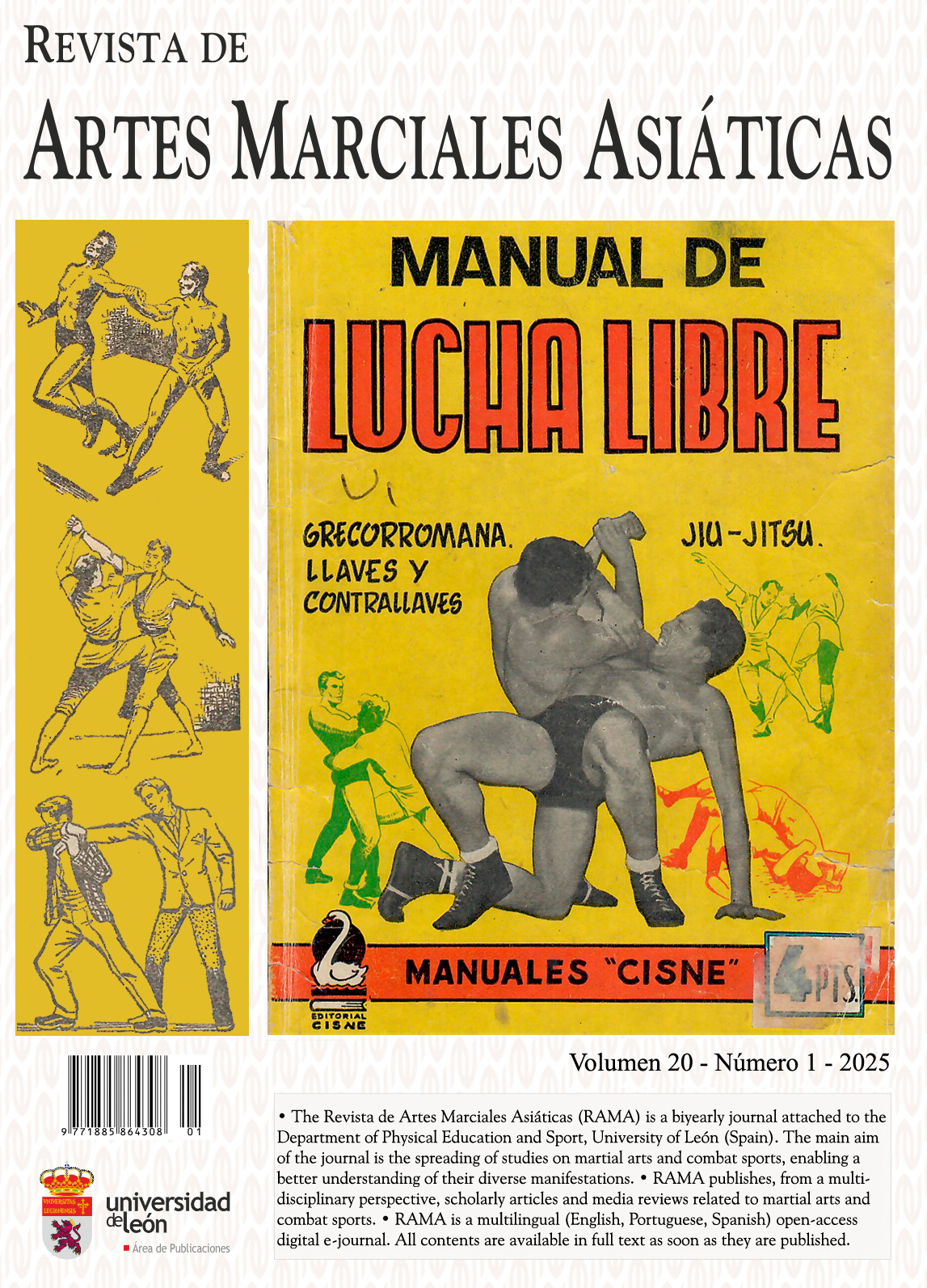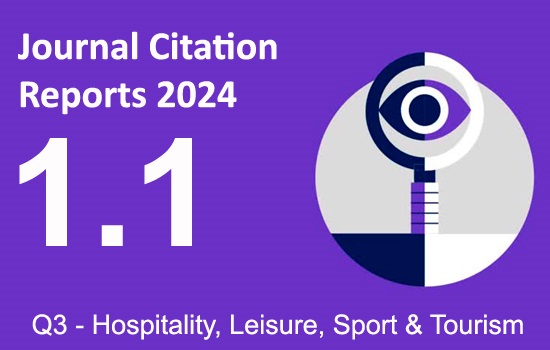La relación entre la práctica regular de artes marciales (judo y lucha olímpica) y las variables neurocognitivas en niños y adolescentes: una revisión de alcance
DOI:
https://doi.org/10.18002/rama.v20i1.2510Palabras clave:
Deportes de combate, artes marciales, judo, lucha, programa de ejercicios, niños, adolescentes, jóvenes, funciones cognitivas, funciones ejecutivas, revisiónAgencias Financiadoras:
This research did not receive any specific grant from funding agencies in the public, commercial, or not-for-profit sectorsResumen
Esta revisión de alcance tiene como objetivo indagar sobre la evidencia existente sobre los efectos del judo y la lucha olímpica en el rendimiento cognitivo de niños y adolescentes. Se siguieron los criterios recomendados por la declaración PRISMA para revisiones de alcance (PRISMA-ScR), desde el inicio hasta marzo de 2025. La búsqueda se realizó en seis bases de datos electrónicas: Web of Science, SCOPUS, PubMed, Sport Discus, ERIC y PsycInfo, además de otros métodos de identificación. Se consideraron elegibles estudios originales que incluyeran la práctica de judo o lucha olímpica, con o sin grupo de control, ya fueran intervenciones agudas o crónicas, en participantes de ambos sexos, con edades comprendidas entre los 6 y los 18 años, y de cualquier nivel competitivo. Para su inclusión, los estudios debían emplear evaluaciones cuantitativas de funciones ejecutivas, rendimiento cognitivo o rendimiento académico. Se identificaron inicialmente 1368 estudios; tras aplicar los criterios de inclusión y exclusión, se seleccionaron 10 artículos que conforman esta revisión exploratoria, con una muestra combinada de 683 participantes (50 % varones). A pesar de la heterogeneidad de las intervenciones en cuanto a tipo y características, los estudios incluidos mostraron de forma consistente una asociación positiva entre la práctica de judo o lucha y diversas variables conductuales y neurocognitivas. No obstante, cabe destacar la calidad metodológica subóptima de los estudios incluidos. Los hallazgos sugieren posibles beneficios en las funciones ejecutivas derivados de la práctica de judo o lucha en población infantil y adolescente. Sin embargo, los resultados deben interpretarse con cautela debido a la escasa investigación rigurosa disponible. Se recomienda que futuros estudios examinen las relaciones dosis-respuesta, considerando variables como edad, maduración, experiencia y la inclusión de grupos control activos.
Descargas
Métricas alternativas
Citas
Álvarez-Bueno, C., Pesce, C., Cavero-Redondo, I., Sánchez-López, M., Martínez-Hortelano, J. A., & Martínez-Vizcaíno, V. (2017). The Effect of Physical Activity Interventions on Children’s Cognition and Metacognition: A Systematic Review and Meta-Analysis. Journal of the American Academy of Child & Adolescent Psychiatry, 56(9), 729–738. https://doi.org/10.1016/j.jaac.2017.06.012
Baek, S.-S. (2016). Role of exercise on the brain. Journal of Exercise Rehabilitation, 12(5), 380–385. https://doi.org/10.12965/jer.1632808.404
Becker, D. R., McClelland, M. M., Geldhof, G. J., Gunter, K. B., & MacDonald, M. (2018). Open-Skilled Sport, Sport Intensity, Executive Function, and Academic Achievement in Grade School Children. Early Education and Development, 29(7), 939–955. https://doi.org/10.1080/10409289.2018.1479079
Chen, C., & Nakagawa, S. (2023). Physical activity for cognitive health promotion: An overview of the underlying neurobiological mechanisms. Ageing Research Reviews, 86, 101868. https://doi.org/10.1016/j.arr.2023.101868
Cho, S. Y., So, W. Y., & Roh, H. T. (2017). The effects of taekwondo training on peripheral Neuroplasticity-Related growth factors, cerebral blood flow velocity, and cognitive functions in healthy children: A randomized controlled trial. International Journal of Environmental Research and Public Health, 14(5). https://doi.org/10.3390/ijerph14050454
Ciaccioni, S., Castro, O., Bahrami, F., Tomporowski, P. D., Capranica, L., Biddle, S. J. H., Vergeer, I., & Pesce, C. (2024). Martial arts, combat sports, and mental health in adults: A systematic review. Psychology of Sport and Exercise, 70, 102556. https://doi.org/10.1016/j.psychsport.2023.102556
Cohen, J. (1988). Statistical Power Analysis for the Behavioral Sciences. In Statistical Power Analysis for the Behavioral Sciences. Lawrence Erlbaum Associates. https://doi.org/10.4324/9780203771587
Colcombe, S., & Kramer, A. F. (2003). Fitness Effects on the Cognitive Function of Older Adults. Psychological Science, 14(2), 125–130. https://doi.org/10.1111/1467-9280.t01-1-01430
Contreras-Osorio, F., Campos-Jara, C., Martínez-Salazar, C., Chirosa-Ríos, L., & Martínez-García, D. (2021). Effects of sport-based interventions on children’s executive function: A systematic review and meta-analysis. Brain Sciences, 11(6). https://doi.org/10.3390/brainsci11060755
Crova, C., Struzzolino, I., Marchetti, R., Masci, I., Vannozzi, G., Forte, R., & Pesce, C. (2014). Cognitively challenging physical activity benefits executive function in overweight children. Journal of Sports Sciences, 32(3), 201–211. https://doi.org/10.1080/02640414.2013.828849
Davis, B., & Byrd, R. J. (1975). Effects of judo on the educable mentally retarded. Journal of Sports Medicine and Physical Fitness, 15(4), 337–341.
de Greeff, J. W., Bosker, R. J., Oosterlaan, J., Visscher, C., & Hartman, E. (2018). Effects of physical activity on executive functions, attention and academic performance in preadolescent children: a meta-analysis.Journal of Science and Medicine in Sport, 21(5), 501–507. https://doi.org/10.1016/j.jsams.2017.09.595
De Waelle, S., Laureys, F., Lenoir, M., Bennett, S. J., & Deconinck, F. J. A. (2021). Children involved in team sports show superior executive function compared to their peers involved in self-paced sports. Children, 8(4). https://doi.org/10.3390/children8040264
Destani, F., Hannon, J. C., Podlog, L., & Brusseau, T. A. (2014). Promoting Character Development through Teaching Wrestling in Physical Education. Journal of Physical Education, Recreation & Dance, 85(5), 23–29. https://doi.org/10.1080/07303084.2014.897570
Donnelly, J. E., Hillman, C. H., Castelli, D., Etnier, J. L., Lee, S., Tomporowski, P., Lambourne, K., & Szabo-Reed, A. N. (2016). Physical Activity, Fitness, Cognitive Function, and Academic Achievement in Children. Medicine & Science in Sports & Exercise, 48(6), 1197–1222. https://doi.org/10.1249/MSS.0000000000000901
Fleisher, S. J., Avelar, C., Latorre, S. E., Ramirez, J., Cubillos, S., Christiansen, H., & Blaufarb, H. (1995). Evaluation of a Judo/Community Organization Program to Treat Predelinquent Hispanic Immigrant Early Adolescents. Hispanic Journal of Behavioral Sciences, 17(2), 237–248. https://doi.org/10.1177/07399863950172007
García-Hermoso, A., Ramírez-Vélez, R., Lubans, D. R., & Izquierdo, M. (2021). Effects of physical education interventions on cognition and academic performance outcomes in children and adolescents: a systematic review and meta-analysis. British Journal of Sports Medicine, 55(21), 1224–1232. https://doi.org/10.1136/bjsports-2021-104112
Giordano, G., Gómez-López, M., & Alesi, M. (2021). Sports, executive functions and academic performance: a comparison between martial arts, team sports, and sedentary children. International Journal of Environmental Research and Public Health, 18(22). https://doi.org/10.3390/ijerph182211745
Grosu, E. F., Grosu, V. T., & Monea, D. (2015). Correlations between Attention, Emotional Distress and Anxiety with Regards to Athletes of 11-15 Years in Perceptual-motor Sports. Universal Journal of Educational Research, 3(8), 508–512. https://doi.org/10.13189/ujer.2015.030805
Haddaway, N. R., Grainger, M. J., & Gray, C. T. (2021, Feb. 16). citationchaser: An R package and Shiny app for forward and backward citations chasing in academic searching. In Zenodo. https://doi.org/10.5281/zenodo.4543513
Hannes, K., & Lockwood, C. (2011). Pragmatism as the philosophical foundation for the Joanna Briggs meta-aggregative approach to qualitative evidence synthesis. Journal of Advanced Nursing, 67(7), 1632–1642. https://doi.org/10.1111/j.1365-2648.2011.05636.x
Hansford, H. J., Wewege, M. A., Cashin, A. G., Hagstrom, A. D., Clifford, B. K., McAuley, J. H., & Jones, M. D. (2022). If exercise is medicine, why don’t we know the dose? An overview of systematic reviews assessing reporting quality of exercise interventions in health and disease. British Journal of Sports Medicine, 56(12), 692–700. https://doi.org/10.1136/bjsports-2021-104977
Herold, F., Müller, P., Gronwald, T., & Müller, N. G. (2019). Dose–Response Matters! – A Perspective on the Exercise Prescription in Exercise–Cognition Research. Frontiers in Psychology, 10(November), 1–17. https://doi.org/10.3389/fpsyg.2019.02338
Higgins, J. P. T., Li, T., & Deeks, J. J. (2023). Chapter 6: Choosing effect measures and computing estimates of effect in Cochrane Handbook for Systematic Reviews of Interventions. In Cochrane Handbook for Systematic Reviews of Interventions version 6.4 (updated August 2023): Vol. 6.4. https://training.cochrane.org/handbook/current/chapter-06
Iadreev, V., Cherkashin, I., Vujkov, S., & Drid, P. (2015). Differences in anthropometric, motoric and cognitive abilities between athletically trained and untrained girls. Biomedical Human Kinetics, 7(1), 73–77. https://doi.org/10.1515/bhk-2015-0012
Kiely, K. M. (2014). Cognitive Function. In Encyclopedia of Quality of Life and Well-Being Research (pp. 974–978). Springer Netherlands. https://doi.org/10.1007/978-94-007-0753-5_426
Lakes, K. D., Bryars, T., Sirisinahal, S., Salim, N., Arastoo, S., Emmerson, N., Kang, D., Shim, L., Wong, D., & Kang, C. J. (2013). The Healthy for Life Taekwondo pilot study: A preliminary evaluation of effects on executive function and BMI, feasibility, and acceptability. Mental Health and Physical Activity, 6(3), 181–188. https://doi.org/10.1016/j.mhpa.2013.07.002
Leahy, A. A., Mavilidi, M. F., Smith, J. J., Hillman, C. H., Eather, N., Barker, D., & Lubans, D. R. (2020). Review of High-Intensity Interval Training for Cognitive and Mental Health in Youth. Medicine & Science in Sports & Exercise, 52(10), 2224–2234. https://doi.org/10.1249/MSS.0000000000002359
Li, W., Kong, X., Zhanng, Y., Luo, Y., & Ma, J. (2021). Effects of combat sports on functional network connectivity in adolescents. Neuroradiology, 63(11), 1863–1871. https://doi.org/10.1007/s00234-021-02713-y
Lindell-Postigo, D., Zurita-Ortega, F., Melguizo-Ibáñez, E., González-Valero, G., Ortiz-Franco, M., & Ubago-Jiménez, J. L. (2023). Effectiveness of a Judo Intervention Programme on the Psychosocial Area in Secondary School Education Students. Sports, 11(8), 140. https://doi.org/10.3390/sports11080140
Lippi, G., Mattiuzzi, C., & Sanchis-Gomar, F. (2020). Updated overview on interplay between physical exercise, neurotrophins, and cognitive function in humans. Journal of Sport and Health Science, 9(1), 74–81. https://doi.org/10.1016/j.jshs.2019.07.012
Lo, W. L. A., Liang, Z., Li, W., Luo, S., Zou, Z., Chen, S., & Yu, Q. (2019). The effect of judo training on set-shifting in school children. BioMed Research International, 2019, 2572016. https://doi.org/10.1155/2019/2572016
Loprinzi, P. D., Moore, D., & Loenneke, J. P. (2020). Does Aerobic and Resistance Exercise Influence Episodic Memory through Unique Mechanisms? Brain Sciences, 10(12), 913. https://doi.org/10.3390/brainsci10120913
Ludyga, S., Gerber, M., Pühse, U., Looser, V. N., & Kamijo, K. (2020). Systematic review and meta-analysis investigating moderators of long-term effects of exercise on cognition in healthy individuals. Nature Human Behaviour, 4(6), 603–612. https://doi.org/10.1038/s41562-020-0851-8
Ludyga, S., Hanke, M., Leuenberger, R., Bruggisser, F., Pühse, U. W. E., Gerber, M., Lemola, S., Capone-Mori, A., Keutler, C., Brotzmann, M., & Weber, P. (2023). Martial Arts and Cognitive Control in Children with Attention-Deficit Hyperactivity Disorder and Children Born Very Preterm: A Combined Analysis of Two Randomized Controlled Trials. Medicine and Science in Sports and Exercise, 55(5), 777–786. https://doi.org/10.1249/MSS.0000000000003110
Ludyga, S., Mücke, M., Leuenberger, R., Bruggisser, F., Pühse, U., Gerber, M., Capone-Mori, A., Keutler, C., Brotzmann, M., & Weber, P. (2022). Behavioral and neurocognitive effects of judo training on working memory capacity in children with ADHD: A randomized controlled trial. NeuroImage: Clinical, 36(August), 103156. https://doi.org/10.1016/j.nicl.2022.103156
Ludyga, S., Tränkner, S., Gerber, M., & Pühse, U. (2021). Effects of Judo on Neurocognitive Indices of Response Inhibition in Preadolescent Children: A Randomized Controlled Trial. Medicine and Science in Sports and Exercise, 53(8), 1648–1655. https://doi.org/10.1249/MSS.0000000000002626
Ludyga, S., Tränkner, S., Gerber, M., & Pühse, U. W. E. (2021b). Effects of Judo on Neurocognitive Indices of Response Inhibition in Preadolescent Children: A Randomized Controlled Trial. Medicine and Science in Sports and Exercise, 53(8), 1648–1655. https://doi.org/10.1249/MSS.0000000000002626
Ma, L. L., Wang, Y. Y., Yang, Z. H., Huang, D., Weng, H., & Zeng, X. T. (2020). Methodological quality (risk of bias) assessment tools for primary and secondary medical studies: What are they and which is better? Military Medical Research, 7(1), 1–11. https://doi.org/10.1186/s40779-020-00238-8
McCuen, E., Svaldi, D., Breedlove, K., Kraz, N., Cummiskey, B., Breedlove, E. L., Traver, J., Desmond, K. f., Hannemann, R. E., Zanath, E., Guerra, A., Leverenz, L., & Talavage, T. M. (2015). Collegiate women’s soccer players suffer greater cumulative head impacts than their high school counterparts. Journal of Biomechanics, 48(13), 3729–3732. https://doi.org/10.1016/j.jbiomech.2015.08.003
Methley, A. M., Campbell, S., Chew-Graham, C., McNally, R., & Cheraghi-Sohi, S. (2014). PICO, PICOS and SPIDER: A comparison study of specificity and sensitivity in three search tools for qualitative systematic reviews. BMC Health Services Research, 14, 579. https://doi.org/10.1186/s12913-014-0579-0
Möhring, W., Klupp, S., Ludyga, S., & Grob, A. (2022). Executive functions in children engaging in open- and closed-skilled sports. Psychology of Sport and Exercise, 61, 102218. https://doi.org/10.1016/j.psychsport.2022.102218
Morales, J., Pellicer-Chenoll, M., García-Massó, X., Gómez, A., Gomis, M., & González, L. M. (2011). Relation between physical activity and academic performance in 3rd-year secondary education students. Perceptual and Motor Skills, 113(2), 539–546. https://doi.org/10.2466/06.11.13.PMS.113.5.539-546
Munn, Z., Peters, M. D. J., Stern, C., Tufanaru, C., McArthur, A., & Aromataris, E. (2018). Systematic review or scoping review? Guidance for authors when choosing between a systematic or scoping review approach. BMC Medical Research Methodology, 18, 143. https://doi.org/10.1186/s12874-018-0611-x
Muntaner-Mas, A., Mazzoli, E., Abbott, G., Mavilidi, M. F., & Galmes-Panades, A. M. (2022). Do Physical Fitness and Executive Function Mediate the Relationship between Physical Activity and Academic Achievement? An Examination Using Structural Equation Modelling. Children, 9(6). https://doi.org/10.3390/children9060823
Origua Rios, S., Marks, J., Estevan, I., & Barnett, L. M. (2018). Health benefits of hard martial arts in adults: a systematic review. Journal of Sports Sciences, 36(14), 1614–1622. https://doi.org/10.1080/02640414.2017.1406297
Ouzzani, M., Hammady, H., Fedorowicz, Z., & Elmagarmid, A. (2016). Rayyan—a web and mobile app for systematic reviews. Systematic Reviews, 5(1), 210. https://doi.org/10.1186/s13643-016-0384-4
Page, M. J., McKenzie, J. E., Bossuyt, P. M., Boutron, I., Hoffmann, T. C., Mulrow, C. D., Shamseer, L., Tetzlaff, J. M., Akl, E. A., Brennan, S. E., Chou, R., Glanville, J., Grimshaw, J. M., Hróbjartsson, A., Lalu, M. M., Li, T., Loder, E. W., Mayo-Wilson, E., McDonald, S., … Moher, D. (2021). The PRISMA 2020 statement: An updated guideline for reporting systematic reviews. The BMJ, 372, 71. https://doi.org/10.1136/bmj.n71
Peng, P., & Kievit, R. A. (2020). The Development of Academic Achievement and Cognitive Abilities: A Bidirectional Perspective. Child Development Perspectives, 14(1), 15–20. https://doi.org/10.1111/cdep.12352
Pyecha, J. (1970). Comparative Effects of Judo and Selected Physical Education Activities on Male University Freshman Personality Traits. Research Quarterly. American Association for Health, Physical Education and Recreation, 41(3), 425–431. https://doi.org/10.1080/10671188.1970.10614993
Rominger, C., Schneider, M., Fink, A., Tran, U. S., Perchtold-Stefan, C. M., & Schwerdtfeger, A. R. (2022). Acute and Chronic Physical Activity Increases Creative Ideation Performance: A Systematic Review and Multilevel Meta-analysis. Sports Medicine - Open, 8(1), 62. https://doi.org/10.1186/s40798-022-00444-9
Rutkowska, K., & Gierczuk, D. (2012). Selected Cognitive And Emotional Resources Of Untrained Youth And Young Wrestlers. Pjst, 19(3), 190–195. https://doi.org/10.2478/v10197-012-0018-x
Samuels, W. E., Tournaki, N., Blackman, S., & Zilinski, C. (2016). Executive functioning predicts academic achievement in middle school: A four-year longitudinal study. The Journal of Educational Research, 109(5), 478–490. https://doi.org/10.1080/00220671.2014.979913
Singh, A. S., Saliasi, E., van den Berg, V., Uijtdewilligen, L., de Groot, R. H. M., Jolles, J., Andersen, L. B., Bailey, R., Chang, Y.-K., Diamond, A., Ericsson, I., Etnier, J. L., Fedewa, A. L., Hillman, C. H., McMorris, T., Pesce, C., Pühse, U., Tomporowski, P. D., & Chinapaw, M. J. M. (2019). Effects of physical activity interventions on cognitive and academic performance in children and adolescents: a novel combination of a systematic review and recommendations from an expert panel. British Journal of Sports Medicine, 53(10), 640–647. https://doi.org/10.1136/bjsports-2017-098136
Slade, S. C., Dionne, C. E., Underwood, M., & Buchbinder, R. (2016). Consensus on Exercise Reporting Template (CERT): Explanation and Elaboration Statement. British Journal of Sports Medicine, 50(23), 1428–1437. https://doi.org/10.1136/bjsports-2016-096651
Souissi, S., Chamari, K., & Bellaj, T. (2022). Assessment of executive functions in school-aged children: A narrative review. Frontiers in Psychology, 13. https://doi.org/10.3389/fpsyg.2022.991699
Sterne, J. A. C., Savović, J., Page, M. J., Elbers, R. G., Blencowe, N. S., Boutron, I., Cates, C. J., Cheng, H. Y., Corbett, M. S., Eldridge, S. M., Emberson, J. R., Hernán, M. A., Hopewell, S., Hróbjartsson, A., Junqueira, D. R., Jüni, P., Kirkham, J. J., Lasserson, T., Li, T., … Higgins, J. P. T. (2019). RoB 2: A revised tool for assessing risk of bias in randomised trials. The BMJ, 366, 14898 https://doi.org/10.1136/bmj.l4898
Sun, Y., Tabeshian, R., Mustafa, H., & Zehr, E. P. (2024). Using Martial Arts Training as Exercise Therapy Can Benefit All Ages. Exercise and Sport Sciences Reviews, 52(1), 23–30. https://doi.org/10.1249/JES.0000000000000326
Takacs, Z. K., & Kassai, R. (2019). The efficacy of different interventions to foster children’s executive function skills: A series of meta-analyses. Psychological Bulletin, 145(7), 653–697. https://doi.org/10.1037/bul0000195
Theeboom, M., & Knop, P. De. (1999). Asian Martial Arts and Approaches of Instruction in Physical Education. European Journal of Physical Education, 4(2), 146–161. https://doi.org/10.1080/1740898990040204
Tomporowski, P. D., McCullick, B., Pendleton, D. M., & Pesce, C. (2015). Exercise and children’s cognition: The role of exercise characteristics and a place for metacognition. Journal of Sport and Health Science, 4(1), 47–55. https://doi.org/10.1016/j.jshs.2014.09.003
Tomporowski, P. D., & Pesce, C. (2019). Exercise, sports, and performance arts benefit cognition via a common process. Psychological Bulletin, 145(9), 929–951. https://doi.org/10.1037/bul0000200
Tricco, A. C., Lillie, E., Zarin, W., O’Brien, K. K., Colquhoun, H., Levac, D., Moher, D., Peters, M. D. J., Horsley, T., Weeks, L., Hempel, S., Akl, E. A., Chang, C., McGowan, J., Stewart, L., Hartling, L., Aldcroft, A., Wilson, M. G., Garritty, C., … Straus, S. E. (2018). PRISMA extension for scoping reviews (PRISMA-ScR): Checklist and explanation. Annals of Internal Medicine, 169(7), 467–473. https://doi.org/10.7326/m18-0850
Wilson, D. B. (n.d.). Practical Meta-Analysis Effect Size Calculator [Online calculator]. Retrieved September 28, 2023, from https://campbellcollaboration.org/research-resources/effect-size-calculator.html
Descargas
Publicado
Cómo citar
Número
Sección
Licencia
Derechos de autor 2025 Marta Sevilla-Sanchez, Xurxo Dopico Calvo, Jose Morales, Eduardo Carballeira

Esta obra está bajo una licencia internacional Creative Commons Atribución-NoComercial-CompartirIgual 4.0.
Los autores que publican en esta revista están de acuerdo con los siguientes términos:
- Los autores ceden de forma no exclusiva los derechos de explotación (reproducción, distribución, comunicación pública, transformación) a la Universidad de León, por lo que pueden establecer, por separado, acuerdos adicionales para la distribución no exclusiva de la versión de la obra publicada en la revista (por ejemplo, alojarlo en un repositorio institucional o publicarlo en un libro), con un reconocimiento de su publicación inicial en esta revista.
- Este trabajo se encuentra bajo la Creative Commons Attribution-NonCommercial-ShareAlike 4.0 International License. Puede consultarse desde aquí la versión informativa y el texto legal de la licencia.
- Se permite y se anima a los autores a difundir electrónicamente las versiones pre-print (versión antes de ser evaluada) y/o post-print (versión evaluada y aceptada para su publicación) de sus obras antes de su publicación, ya que favorece su circulación y difusión más temprana y con ello un posible aumento en su citación y alcance entre la comunidad académica.











